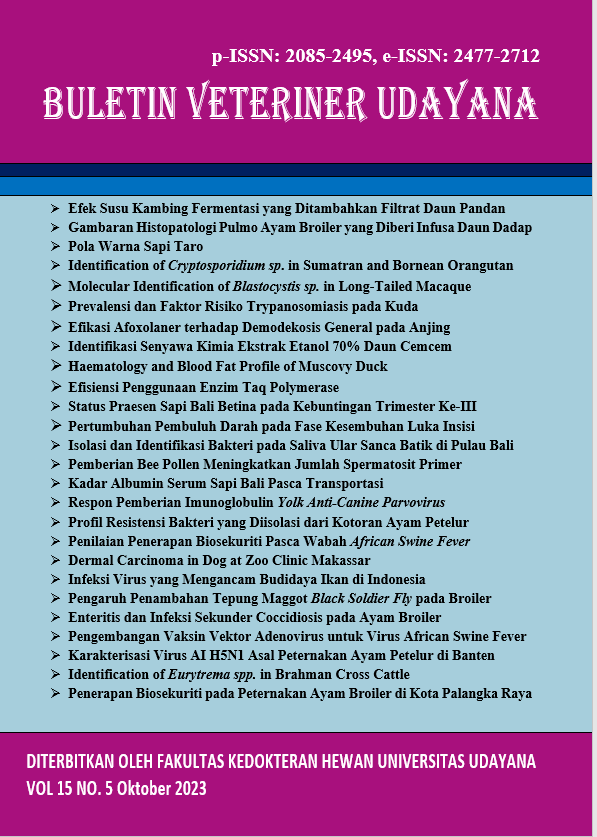ISOLATION AND IDENTIFICATION OF BACTERIA IN THE SALIVA OF A RETICULATED PYTHON ON THE ISLAND OF BALI
Abstract
The problem of wildlife is increasing every year, ranging from health to the environment and one of them is snakes. The more disturbed the habitat of snakes, the issue of snake bites become an increasing problem. One example is the reticulated python located in Bali, not only humans but other animals can also be bitten. In the snake's oral cavity, there are bacteria that can infect the bitten victim. This study aims to isolate and identify bacteria in the oral cavity of local Balinese reticulated pythons that live in nature. This research was conducted with a descriptive observational design. Samples were taken directly from the snake's oral cavity using a sterile cotton swab and inserted into the Stuart media so that it was stored in a clean cooler box. This study used 8 saliva samples of local Balinese reticulated pythons that live in nature, which were cultured using transport media Stuart Agar, Blood Agar culture media, MacConkey, Eosin Methylene Blue Agar (EMBA) and Salmonella Shigella Agar (SSA). bacterial identification media Indol, Methyl red, Voges-Proskauer, indole motility sulfide, simmons citrate (IMViC) and TSIA test, sugar fermentation test (glucose, lactose, sucrose, maltose), and Gram staining test Crystal violet (Gram positive), Safranin (Gram negative), other ingredients such as 70% alcohol, aquadest. Identification of samples in the laboratory of the Healthy Animal Clinic in Malang City. The results of this study found that 8 samples of saliva of local Balinese reticulated python snakes identified 1 sample (12, 5%) found the presence of Enterobacter sp. bacteria, 2 samples (25%) found Serratia sp., Klebsiella sp. 1 sample (12.5%), Salmonella sp. in 2 samples (25%), E. coli in 1 sample (12.5%) and Proteus sp. in 1 sample (12.5%). The need for further research on the finding of Salmonella sp. in 25% of saliva samples of reticulated pythons, and also further research on the discovery of Serratia sp. in 25% of snake saliva samples.
Downloads
References
Chen CM, Wu KG, Chen CJ, Wang CM. 2011. Bacterial infection in association with snakebite: Aá10-year experience in a northern Taiwan medical center. J. Microbiol. Immunol. Infect. 44(6): 456-460.
Dehghani R, Sharif MR, Moniri R, Sharif A, Kashani H. 2016. The identification of bacterial flora in oral cavity of snakes. Comp. Clin. Pathol. 25(2): 279-283.
Dipineto L, Russo TP, Calabria M, De Rosa L, Capasso M, Menna LF, Fioretti A. 2014. Oral flora of P ython regius kept as pets. Letters Appl. Microbiol. 58(5): 462-465.
Jho YS, Park DH, Lee JH, Cha SY, Han JS. 2011. Identificationof bacteria from the oral cavity and cloaca of snakes imported from Vietnam. Lab. Anim. Res. 27(3): 213–217.
Krishnankutty SP, Muraleedharan M, Perumal RC, Michael S, Benny J, Balan B, Zachariah A. 2019. Next-generation sequencing analysis reveals high bacterial diversity in wild venomous and non-venomous snakes from India. J. Venomous Anim. Toxins Incl. Trop. Dis. 24(41): 1-11.
Marlon R. 2014. Panduan visual dan identifikasi lapangan 107+ ular Indonesia. Jakarta: Indonesia Nature and Wildlife Publishing. Pp 42-43.
Putranto DI, Yuda P, Zahida F. 2016. Keanekaragaman reptil impor di Yogyakarta. Biota: J. Ilmiah Ilmu-Ilmu Hayati. 1(3): 117-125.
Yak R, Lundin AC, Pin PY, Sebastin SJ. 2015. Oral bacterial microflora of free-living reticulated pythons (Python reticulatus) in Singapore. J. Herpetol. Med. Surg. 25(1-2): 40–44.





